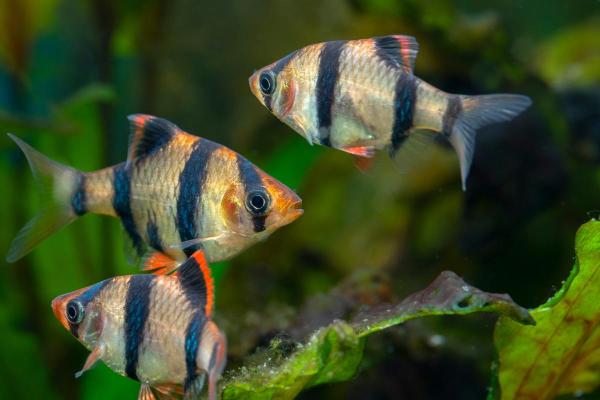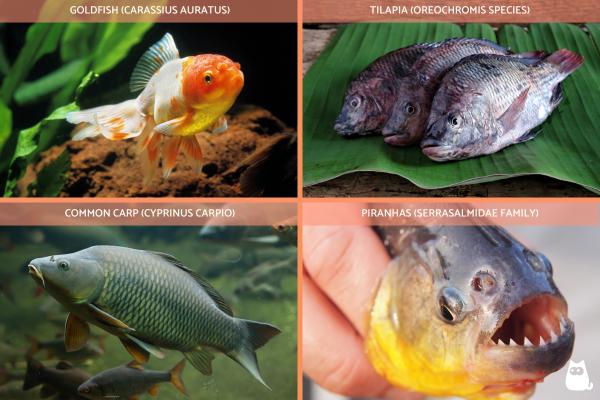
Omnivorous fish are water creatures that eat both plants and animals. Unlike fish that only eat one type of food, these adaptable eaters have bodies that can handle different food sources. They can eat things like algae and water plants, as well as insects, tiny shellfish, and smaller fish. This ability to eat different things helps them live in many different water environments and deal with changing conditions. Being able to switch between food sources gives them a better chance of surviving when their environment changes or certain foods become hard to find.
The following AnimalWised article explores what omnivorous fish are, including their evolutionary adaptations, diverse classifications, and notable examples.
What are omnivorous fish?
Many fish species are omnivores, consuming both plant material and animal prey as part of their natural diet. This dietary flexibility represents an important ecological adaptation that allows these species to thrive across diverse aquatic environments.
This omnivorous feeding strategy provides several benefits:
- When one food source becomes scarce, omnivorous fish can switch to alternatives.
- Different food sources provide complementary nutrients, supporting overall health.
- The ability to utilize multiple food resources allows omnivores to avoid direct competition with specialized feeders.
These adaptable fish have evolved digestive systems capable of processing both plant cellulose and animal proteins, with anatomical features that reflect their diverse diet requirements. Their intestines are typically medium-length. It is not as long as plant-eaters (who need extra time to break down tough plant fibers) but not as short as meat-eaters (who process protein more quickly).
In terms of enzymes, omnivorous fish can produce a wider range of digestive enzymes than fish that only eat one thing. Unlike herbivores, which mostly use enzymes to break down plant material, or carnivores, which mostly use enzymes to break down protein, omnivores have a balance of enzymes that can handle different kinds of food.
Omnivorous fish are somewhere in between fish that only eat plants (herbivores) and fish that only eat meat (carnivores). Their bodies show this in-between state. These fish have developed several adaptations to help them find and eat different foods:
- Sharp eyesight to spot both stationary plants and moving prey.
- Flexible mouth structures for different feeding techniques.
- Enhanced color vision to identify various food sources.
- Different hunting and gathering behaviors.
Omnivorous fish frequently adapt their feeding habits based on a variety of factors. Seasonal shifts often lead to changes in their diet, with many species consuming more plant matter during periods of growth and a greater proportion of animal protein at other times.
Habitat conditions also play a significant role, as the specific food items consumed will differ depending on whether the fish resides in rivers, lakes, estuaries, or marine environments. Furthermore, their opportunistic nature allows them to alter their diet in response to fluctuations in food availability.
The time of day can also influence feeding patterns, with some omnivores being primarily active during daylight hours, while others are more active at dawn, dusk, or night.
This dietary flexibility provides a significant evolutionary advantage, allowing omnivorous fish to thrive in changing environments. When conditions shift, whether due to natural events or human impact, their ability to consume a variety of food sources often gives them a better chance of survival compared to fish with more specialized diets. As a result, omnivorous fish can be found in virtually every aquatic habitat imaginable.

What do omnivorous fish eat?
Omnivorous fish consume a diverse diet that includes both plant and animal matter. Their feeding habits vary significantly based on their habitat, which directly determines what food sources are available to them.
Plant-based foods:
- Algae: many omnivorous fish graze on various types of algae growing on rocks, plants, and other surfaces, which provide fiber, vitamins, and essential minerals.
- Aquatic plants: they consume leaves, stems, and roots of water plants.
- Fallen fruits and seeds: species like piranhas and pacu will eat fruits and seeds that fall into the water from overhanging vegetation.
- Phytoplankton: Microscopic plant organisms suspended in water serve as an important food source for many omnivorous fish.
Animal-based foods:
- Insects and larvae: both aquatic insects and those that fall into the water provide a rich source of protein.
- Small crustaceans: tiny shrimp, copepods, and other crustaceans are commonly consumed.
- Zooplankton: animal-based microscopic organisms floating in the water column.
- Worms: various aquatic worms make up part of an omnivore's diet.
- Smaller fish: larger omnivorous fish may consume juvenile fish of other species.
- Mollusks: snails and small bivalves are eaten by omnivores with stronger jaws or pharyngeal teeth.
- Organic matter and remains: in certain aquatic environments, omnivorous fish consume decomposing material, playing an important role in nutrient cycling within these ecosystems.
Find out more about fish feeding adaptations in our article exploring the unique anatomy inside a fish's mouth.
Types of omnivorous fish
Omnivorous fish inhabit virtually every aquatic environment on our planet, from tropical rivers to arctic seas. Their adaptive feeding strategies have contributed to their success across these diverse habitats. While omnivory appears in numerous fish families, the specific plant and animal foods available to these versatile feeders vary dramatically depending on where they live. Let us take a closet look at how their habitat shapes their feeding behaviors:
Freshwater omnivores:
Freshwater omnivorous fish are successful inhabitants of lakes, rivers, streams, and ponds in various regions around the world. Omnivores residing in lakes often consume a mix of submerged aquatic plants, algae growing on surfaces, insect larvae, and small crustaceans.
In rivers and streams, omnivorous fish typically adapt to the flowing water conditions, feeding on both attached algae and drifting invertebrates. The seasonal changes common in freshwater environments, such as temperature variations, fluctuations in water levels, and vegetation cycles, frequently influence the feeding patterns of these freshwater fish.
Brackish water omnivores:
Brackish water omnivores make their homes in the dynamic transition zones where freshwater meets the sea, such as estuaries, mangrove forests, and coastal lagoons.
These fish have developed impressive physiological adaptations that allow them to cope with fluctuating salinity levels while maintaining a diverse diet. Omnivores living in estuaries often feed on a combination of decaying organic matter (detritus), algae, small invertebrates, and sometimes even smaller fish.
The distinctive advantage of brackish water omnivores is their capacity to utilize food resources originating from both freshwater and marine environments.
Marine omnivores:
Marine omnivorous fish inhabit various oceanic zones, from shallow coastal waters to coral reef systems. These species have adapted to consume both the diverse algae and seaweeds of marine environments, along with a wide variety of marine invertebrates.
Reef-dwelling omnivores often scrape algae from coral surfaces while also feeding on small crustaceans, worms, and other invertebrates living within the reef structure.
Beyond habitat-based classification, omnivorous fish can also be categorized by feeding strategy, feeding adaptations, and foraging technique (grazers, filterers, or hunter/gatherers). Some fish may also be classified based on seasonal dietary shifts, morphological adaptations for omnivory, or taxonomic relationships. Each classification system provides valuable insights into the ecological roles and evolutionary adaptations of these versatile aquatic species.
Curious about fish behavior? Discover the surprising ways fish rest and recharge in our fascinating article about aquatic slumber patterns.

Examples of omnivorous fish
Omnivory occurs across many fish families and habitats globally, but some species are notable for their recognition or ecological importance. The following eight examples represent well-known omnivorous fish, each illustrating the success of this feeding strategy in diverse aquatic environments.
Goldfish (Carassius auratus):
Perhaps the most familiar omnivorous fish to most people, goldfish readily consume a diverse diet including algae, aquatic plants, small insects, worms, crustaceans, and commercial fish foods. Originally native to East Asia, centuries of selective breeding have produced numerous varieties that maintain this dietary flexibility. Their omnivorous nature contributes significantly to their hardiness and popularity as both pond and aquarium fish worldwide.
Tilapia (Oreochromis species):
These fish are classic omnivores that consume blue-green algae, diatoms, aquatic plants, detritus, small invertebrates, fish eggs, and occasionally smaller fish. Their ability to thrive on diverse food sources has made them excellent candidates for aquaculture, where they can be raised on relatively inexpensive plant-based feeds supplemented with minimal animal protein.
Common Carp (Cyprinus carpio):
Found across multiple continents, these highly adaptable fish feed on aquatic vegetation, algae, seeds, insects, crustaceans, worms, and other benthic organisms. Their feeding behavior often involves rooting through bottom sediments, which can increase water turbidity. Carp possess specialized pharyngeal teeth that allow them to crush both plant matter and shellfish.
Piranhas (Serrasalmidae family):
Despite their fearsome reputation as aggressive predators, many piranha species consume substantial amounts of plant material. Red-bellied piranhas (Pygocentrus nattereri) and other species regularly eat fruits, nuts, and seeds that fall into Amazon basin waters during flood seasons. Their powerful jaws and sharp teeth, while excellent for carnivory, also effectively process tough plant materials.
Channel Catfish (Ictalurus punctatus):
This popular North American sport and food fish possesses a varied diet including aquatic plants, seeds, algae, insects, crustaceans, mollusks, worms, and smaller fish. Their nocturnal feeding habits and well-developed sensory barbels help them locate diverse food items in murky waters or darkness. Young channel catfish tend to consume more invertebrates, while larger individuals incorporate more fish and plant matter into their diet, demonstrating how omnivory can shift throughout their lifecycle.
Oscar fish (Astronotus ocellatus):
These intelligent cichlids native to Amazon basin waters naturally consume fruits, nuts, leaves, insects, crustaceans, and smaller fish. Oscars have relatively strong jaws and pharyngeal teeth that allow them to crush hard seeds and shellfish. Their inquisitive nature and food adaptability have contributed to their popularity in the aquarium hobby despite their large size.
Surgeonfish/Tang (Acanthuridae family):
These marine reef-dwellers are primarily known for grazing on algae, but regularly supplement their diet with zooplankton, tiny crustaceans, and other small invertebrates. Their specialized digestive systems have evolved to process tough algae but retain the ability to extract nutrients from animal protein. Their ecological role in controlling algal growth on coral reefs is crucial to reef health.
Rudderfish (Girella nigricans):
These Pacific coast fish demonstrate classic omnivorous adaptability by shifting their diet seasonally. During warmer months, they consume primarily algae and seaweeds, but in cooler seasons when plant growth slows, they increase their intake of small crustaceans, mollusks, worms, and other invertebrates. This flexibility allows them to maintain stable populations throughout the year despite seasonal resource fluctuations.
Want to understand more about fish biology? Our related article explains the surprising diversity of reproductive strategies fish have evolved.


If you want to read similar articles to Which Types of Fish Are Omnivores?, we recommend you visit our Facts about the animal kingdom category.
- Animal Diversity Web. (2020). https://animaldiversity.org/
- Doherty, E. (2022, June 10). What do fish eat? Your guide to feeding pet fish. PetMD. https://www.petmd.com/fish/what-do-fish-eat-your-guide-feeding-pet-fish
- Hickman, C., Roberts, L., & Parson, A. (2000). Comprehensive principles of zoology. McGraw Hill Interamericana.
- Sales, J., & Janssens, G. P. J. (2020). Nutrition research on teleost fish: Feed formulation implications. Comparative Biochemistry and Physiology Part A: Molecular & Integrative Physiology, 251, 110825. https://doi.org/10.1016/j.cbpa.2020.110825
- Wagner, C. E., & Olden, J. D. (2022). Omnivory and diet diversity in fishes: Patterns, drivers, and consequences. Frontiers in Ecology and Evolution, 10, 856258. https://doi.org/10.3389/fevo.2022.856258